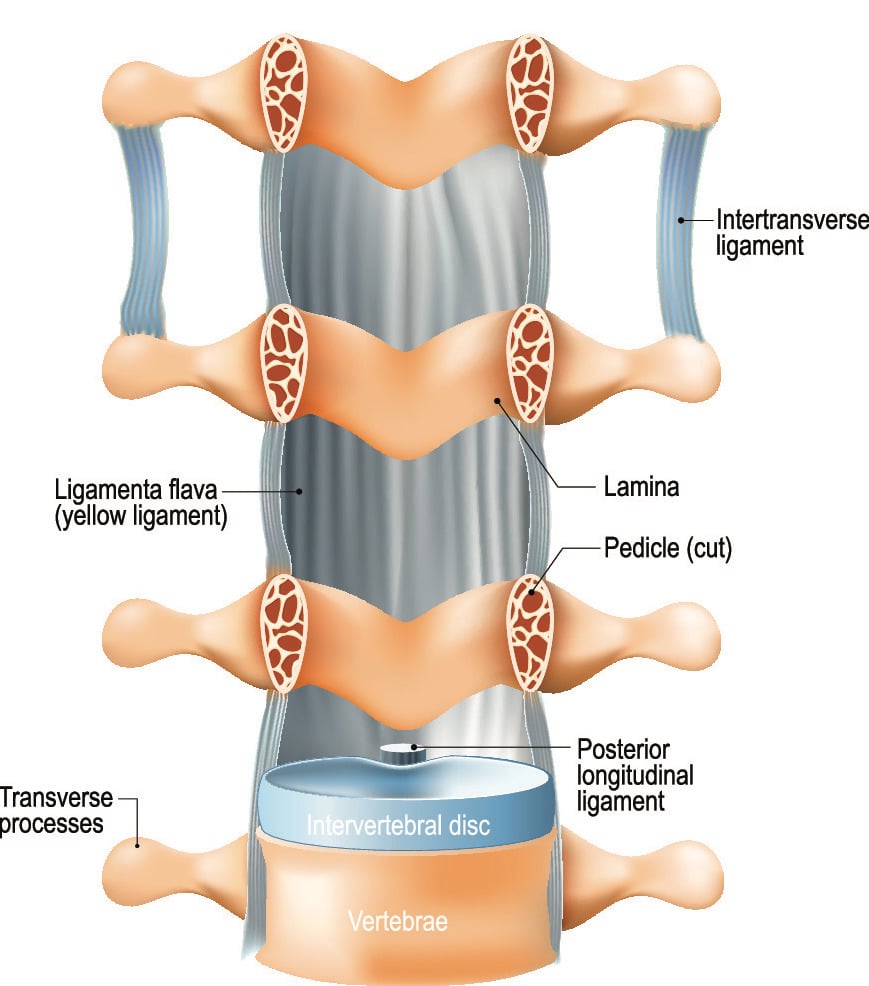What is Ligamentum Flavum Hypertrophy?
Ligamentum Flavum Hypertrophy, also known as Ligamentum Flavum Thickening, refers to the enlargement or thickening of a ligament called the Ligamentum Flavum, which is present in the spinal column. The Ligamentum Flavum is one of the ligaments that connect the vertebrae (bones) of the spine and help stabilize the spinal column while maintaining its flexibility.

Causes of Ligamentum Flavum Hypertrophy
The exact cause of Ligamentum Flavum Hypertrophy is not fully understood, but it is generally associated with the natural aging process of the spine. As we grow older, the ligaments in our spine, including the Ligamentum Flavum, may undergo changes, leading to hypertrophy. However, several factors can contribute to the development of this condition:
- Degenerative Disc Disease: Degenerative changes in the intervertebral discs, which act as shock absorbers between the vertebrae, can put extra stress on the Ligamentum Flavum. The increased load on the ligament can cause it to thicken over time.
- Injury or Trauma: Previous injuries to the spine, such as from accidents or falls, can initiate the hypertrophy process. In response to the injury, the ligament may thicken to stabilize the affected area.
- Genetic Predisposition: Some individuals may have a genetic tendency to develop Ligamentum Flavum Hypertrophy. This genetic predisposition could make their ligaments more susceptible to thickening with age or other contributing factors.
- Obesity: Excess body weight can increase the load on the spine, leading to additional stress on the ligaments, including the Ligamentum Flavum. Over time, this increased stress may contribute to hypertrophy.
Symptoms of Ligamentum Flavum Hypertophy
In many cases, patients may not experience any noticeable symptoms, and the condition may be discovered incidentally during medical imaging for unrelated reasons. However, when symptoms do occur, its is caused by spinal cord or spinal nerve root compression from the ligamentous thickening. These symptoms may include:
- Back Pain: Dull or achy pain in the lower back is a common complaint in individuals with Ligamentum Flavum Hypertrophy. The pain may be persistent or intermittent.
- Leg Pain: The thickened Ligamentum Flavum can compress the spinal nerves that exit the spinal column, leading to pain that radiates into the buttocks, thighs, or legs. This pain may follow the path of the affected nerve and is often described as shooting or burning in nature.
- Numbness and Tingling: Patients with hypertrophy of the Ligamentum Flavum may experience sensations of numbness or tingling in the legs. This occurs due to the compression of spinal nerves that supply sensation to the lower extremities.
- Weakness: Muscle weakness may occur in the legs due to nerve compression. This weakness can affect one or both legs and may interfere with walking or standing.
Diagnosis
Ligamentum flavum hypertophy is best visualized on magnetic resonance imaging (MRI). An MRI scan uses powerful magnets and radio waves to produce detailed images of the soft tissues, including ligaments, discs, and nerves. It can help visualize the thickened Ligamentum Flavum and assess its impact on nearby structures.
Treatment of Ligamentum Flavum Hypertrophy
The treatment for Ligamentum Flavum Hypertrophy depends on the severity of symptoms, the impact on daily life.. In many cases, conservative, non-surgical treatments are initially recommended, while surgery may be considered for more severe or refractory cases.
Conservative treatments include:
- Physical Therapy: Specific exercises and stretches can help improve flexibility, strengthen the core muscles, and reduce pressure on the affected area.
- Pain Management: Over-the-counter pain medications or prescription medications may be used to manage pain and inflammation, as directed by a healthcare professional.
- Epidural Steroid Injections: In some cases, corticosteroid injections may be administered directly into the affected area to reduce inflammation and provide temporary pain relief.
If ligamentum flavum hypertrophy is causing severe compression of the spinal cord or nerve roots, then surgery many be indicated.
One such procedure, called a laminectomy, involves the removal of a portion of the lamina (a part of the vertebrae) to create more space for the spinal nerves and relieve compression.
Summary
Ligamentum Flavum Hypertrophy refers to the enlargement or thickening of the Ligamentum Flavum in the spine. While the exact cause is not fully understood, it is commonly associated with aging and factors such as degenerative disc disease, injury, genetic predisposition, and obesity may contribute to its development. Symptoms may include back pain, leg pain, numbness, and weakness due to spinal nerve compression. Diagnosis is made through MRI imaging and treatment options range from conservative approaches like physical therapy and pain management to surgical intervention.